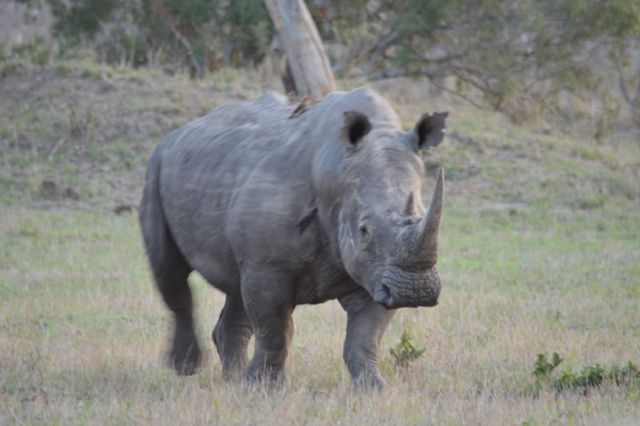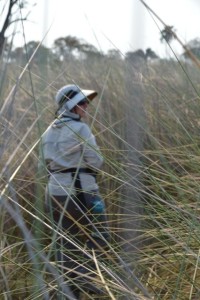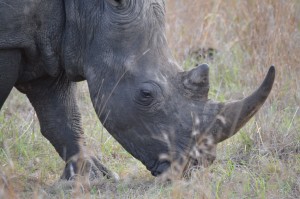
 By Jill Hedgecock
By Jill Hedgecock
Jill Hedgecock, the Diablo Gazette Bookends columnist, became passionate about the fate of rhinos during an African safari vacation last October. After learning that three of these magnificent creatures are killed illegally each day in South Africa, she decided that people needed to learn more about what is happening. Hedgecock is a biologist and holds a Master’s degree in Environmental Management. She presented photos from her recent African safari trip to the Mount Diablo Audubon Society and discussed the plight of the rhinos. Highlights of that presentation in revealed in this article.
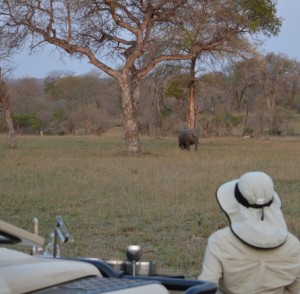
Like most people, Jill went on a safari to see the legendary Big Five — not the largest animals, but the five most dangerous land mammals: rhinoceros, elephant, cape buffalo, lion and leopard. She was lucky to see all five.
But tourists may soon have to downsize their list to the Big Four because rhinos are disappearing at an alarming rate. Driven by greed, poachers kill them for the profitable horn. A single rhino horn can sell for a half-million dollars on the Asian black market. An ounce of rhino horn is currently more valuable than gold. If the current rate of rhino horn poaching isn’t stopped, wild black rhinos could become extinct within the next decade.
 Rhinos, in addition to being a draw for tourists, serve a critical function in maintaining a healthy ecosystem. A 5,000-pound white rhino can consume 50 or more pounds of food in one day. But it is not the sheer bulk of vegetation consumed that makes them so important. Unlike elephants who browse on trees, rhinos act as giant weed whackers, selectively grazing on certain plants and grasses, creating biodiversity in the landscape. These dietary preferences also create a mosaic patchwork of habitat that is more attractive for other grazers such as zebra and antelope, who, in turn, are food for lions, leopards, and hyenas.
Rhinos, in addition to being a draw for tourists, serve a critical function in maintaining a healthy ecosystem. A 5,000-pound white rhino can consume 50 or more pounds of food in one day. But it is not the sheer bulk of vegetation consumed that makes them so important. Unlike elephants who browse on trees, rhinos act as giant weed whackers, selectively grazing on certain plants and grasses, creating biodiversity in the landscape. These dietary preferences also create a mosaic patchwork of habitat that is more attractive for other grazers such as zebra and antelope, who, in turn, are food for lions, leopards, and hyenas.
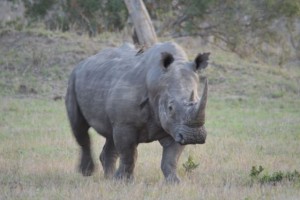 Worldwide, four of the remaining five rhino species are threatened. Three are critically endangered. In the early 19th century, approximately one million rhinos roamed the world. In 1970, their numbers fell to around 70,000 or seven percent of their peak population. Today, there are only around 28,000 rhinos surviving in the wild. In South Africa alone three rhinos are killed every day.
Worldwide, four of the remaining five rhino species are threatened. Three are critically endangered. In the early 19th century, approximately one million rhinos roamed the world. In 1970, their numbers fell to around 70,000 or seven percent of their peak population. Today, there are only around 28,000 rhinos surviving in the wild. In South Africa alone three rhinos are killed every day.
No wild rhino is safe, not even the rarest. After the miraculous discovery of a small population of Sumatran rhino in Borneo, a species previously thought to be extinct for 40 years, tragedy struck. Despite efforts to treat a leg injury from a poaching snare, one of these precious rhinos died from an infection on April 5, 2016. There are now only fourteen Sumatran rhinos in the East Kalimantan jungle. Other rare rhinos are on the brink too. Only three northern white rhinos and 6,487+ black rhinos are left in the world today.
The demand for the keratinous material in the horn in the Asian culture appears to be insatiable. The misguided belief that the horn powder has curative powers for everything from hangovers to impotency to cancer has created a frenetic seller’s market, driven largely by China and Vietnam. What these people are spending fortunes on is essentially the same material as fingernails.
England’s Prince William, who serves as president of United for Wildlife, a consortium of wildlife charities, has recently become a strong advocate for the rhino. On March 15, 2016, at Buckingham Palace, he unveiled a global agreement to crack down on wildlife trafficking routes. Forty transportation authorities, representing airline, shipping and custom agency leaders signed the declaration to stop the movement of poached animals and their associated products into the black market.
British royalty isn’t the only celebrities using a public platform to try to stop rhino horn poaching. Film stars, including Maggie Q (“Mission Impossible III and Nikita“) have been part of an ad campaign showing the stars gnawing on their fingernails to help educate people that rhino horn has no health benefits. WildAid and the African Wildlife Foundation launched the promotion in both the Chinese and English languages. In 2014 the Vietnamese Ministry of Health confirmed that rhino horn had no medicinal value, but this has had little impact. The hope is that a Vietnamese campaign starring some of their country’s biggest celebrities will have better success.
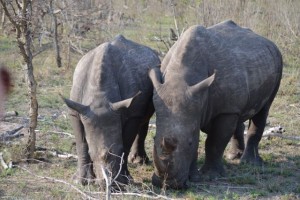 Many solutions are being considered to address the poaching problem. Dehorning, once thought to be a magic solution, has largely failed. Poachers either not wanting to track a rhino without a horn or to secure the limited amount of stub of horn still left, will still shoot the animal. In Hwange National Park, Zimbabwe, during the early 1990s, the majority of dehorned rhinos were killed just 12 to 18 months after being dehorned. The dehorning operation is also risky due to veterinary complications while the animal is under anesthetic that may result in death. In addition, dehorned rhinos are at risk of being unable to adequately protect themselves and their young.
Many solutions are being considered to address the poaching problem. Dehorning, once thought to be a magic solution, has largely failed. Poachers either not wanting to track a rhino without a horn or to secure the limited amount of stub of horn still left, will still shoot the animal. In Hwange National Park, Zimbabwe, during the early 1990s, the majority of dehorned rhinos were killed just 12 to 18 months after being dehorned. The dehorning operation is also risky due to veterinary complications while the animal is under anesthetic that may result in death. In addition, dehorned rhinos are at risk of being unable to adequately protect themselves and their young.
Other options being proposed to combat this incredibly complex and controversial issue include poisoning the rhino horn, developing synthetic horn material, legalizing trade, improving anti-poaching techniques, and relocation of rhinos out of high poaching areas.
Poisoning the horn seemed like a fail-proof solution to make rhino horns worthless. A colored toxic dye that didn’t hurt the rhino was injected into the horn and the outer skin of the rhino’s horn was painted a bright color. But poachers soon discovered that the poison didn’t spread throughout the dense fiber of the rhino horn.
Critics of the synthetic horn believe that fake horn will drive up the cost of poached rhino horn, creating an even bigger market for a product seen as more potent and, therefore, more desirable. The International Rhino Foundation (IRF) opposes the sale of synthetic horns.
Opponents of legalization believe it will only create more demand and could lead to the establishment of rhino horn farms. Because rhino horns regrow, sustainable farming has been suggested, but this has raised ethical issues. To the relief of many rhino protection groups, on April 21, 2016, South Africa announced that it would continue to oppose legalization of rhino horn trade. Legalizing the sale of tiger bone and cultivated ginseng resulted in a rise in the use of both. While the connoisseurs of rhino horn are mainly successful Asian men over the age of forty who buy entire horns as a symbol of their wealth, there are more potential customers waiting for the price to drop. This could represent millions of middle-class consumers in Southeast Asia.
Anti-poaching activities have largely failed in most areas of Africa, although efforts in some countries have met with limited success. The areas where rhinos roam are large, often in terrain with limited sight distance. Fueled by black market dollars, poachers are often outfitted with the latest technological tracking tools. Funding game wardens with anti-poaching equipment such as drones, trained dogs, and night-vision binoculars have helped. One game reserve in a province of South Africa, Limpopo, is reporting success using military thermal cameras to track the movement of poachers. Overall, 40 fewer rhinos were poached between 2014 and 2015 in South Africa. But considering that 13 rhinos were killed in 2007 compared to 1,349 in 2015, game wardens may occasionally win a battle, but it appears they are still losing the war.
The Rhinos Without Borders campaign based in South Africa seeks to relocate rhinos from high poaching areas. They hope to move 25 rhinos to Botswana by the end of the year. This effort comes with a high price tag ($45,000 per rhino). Other efforts to establish a breeding rhino population outside Africa involve the relocation of 80 rhinos from Africa to Australia over the next four years. It remains to be seen if this relocation will work and with up to a sixteen-month gestation, replenishing wild rhino populations will not happen quickly. Still, these transplants may have a better chance of success than if they were sent to zoos. Rhinos born in captivity rarely bear young. However, here in California at the San Diego Zoo Safari Park, on April 7, 2016, a southern white rhino was finally born to a captive female after ten years of breeding efforts. The success was attributed to a change in the mother’s diet. An Indian rhino calf was born in the Toronto zoo in February and the male calf appears to be thriving. It is unlikely that the rhinos currently living in zoos will be able to save the species from extinction. But these recent births give cause for hope.
There is no single answer to combat the current rhino poaching crisis, but time is running out. One of the Big Five safari animals isn’t inching its way toward extinction, its population is plummeting. But the rhino, this “landscape architect” of the African savannah, must be saved. They are too valuable.
For more information about the plight of the rhino and other endangered animals visit: https://worldanimalfoundation.org/advocate/poaching-statistics/
SAVE THE RHINO BY PURCHASING A UNIQUE GIFT
The International Rhino Foundation is promoting An Adopt a Rhino campaign. Simply sponsor a specific rhino and receive a thank you packet with a personalized adoption certificate and a rhino photograph http://rhinos.org/adopt/ for photos and more information.
The International Rhino Foundation hosts a shopping webpage that sells rhino-inspired jewelry and clothing: https://irf.z2systems.com/np/clients/irf/giftstore.jsp
More Safari Photos with comments from Hedgecock:
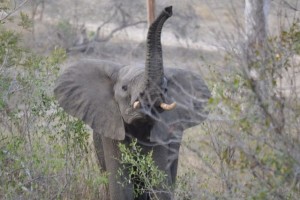
 In Botswana, the guides are not allowed to carry guns. It is a little disconcerting to say the least.
In Botswana, the guides are not allowed to carry guns. It is a little disconcerting to say the least.
In South Africa, we only were on foot one game “drive” and our guide carried a rifle. We encountered elephants. It was a whole different experience when you are out of the car. A few photos for fun (Yes, we were that close to the elephant, with only a fallen branch between us if it had decided to charge). We were upwind. It raised its trunk when it sensed us. Elephants (and rhinos) are nearly blind. Elephants use smell and hearing to detect danger.
Elephant Jawbone Botswana – walking through reeds A Sausage Tree
(this article has been updated to reflect more current black rhino population as of October 2023.)

